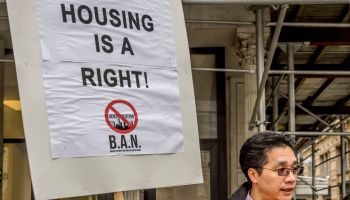By Phill Wilson / theGrio.com
Today is National Black HIV/AIDS Awareness Day. Like other days of observation, it is a time to reflect, face sometimes hard-to-acknowledge realities, celebrate triumphs, and lament tragedies. This year’s theme is “Changing the Course of HIV/AIDS, One Black Life at a Time.”
Despite initially being mischaracterized, HIV/AIDS has disproportionately affected black Americans since the very beginning of the epidemic. Today we comprise 14 percent of the U.S. population but account for 44 percent of all new HIV infections. Young black gay and bisexual men are especially at risk. Meanwhile the estimated rate of new HIV infections for black women is more than 15 times as high as the rate for white women, and more than three times as high as that of Latina women. And while we are making tremendous progress to fight the stigma associated with HIV/AIDS, too much misplaced blame, misinformation and a general lack of outrage and personal responsibility still exists in our communities.
That said, we are at a deciding moment in the trajectory of the AIDS epidemic. We have the means to end the AIDS epidemic. Research findings over the last two years have ushered in new biomedical tools that are dramatically more promising than anything we’ve seen in the past.
Yet, this good news does not represent a victory achieved. Rather, it poses a challenge that lies ahead. Indeed, to put these new scientific tools to use, we must overcome formidable obstacles. But for the first time, we have the tools.
First, we must first get proactive about HIV testing, prevention and treatment. I cannot emphasize enough that HIV is a disease of opportunity. It gets more and more difficult to fight once it gets ahead of you.
We now know that taking effective antiretroviral drugs makes infected people much less infectious. If we know our status and take our medication, we are far less likely to infect our partners. So if we can provide treatment on demand for every HIV-positive person (something we should do anyway to improve their health and keep them alive), keep them in care and suppress their viral load (the amount of virus in their body), we can also slow the torrent of new infections to a trickle.
This is called “treatment as prevention,” and it is the most important advance in over a decade. If we can deploy it effectively, we can turn off the spigot of new infections and, over time, end the AIDS epidemic.
The Black AIDS Institute is releasing its eighth annual State of AIDS in Black America report, in which we sketch out a four-part plan for ending the AIDS epidemic in black communities.
First, every black American must know his or her HIV status. HIV testing needs to become a routine, frequent and fundamental component of health care for black Americans.
Second, every person who tests HIV-positive must be connected to comprehensive medical care, including antiretroviral therapy.
Third, prevention strategies must be expanded. Traditional approaches to HIV prevention such as condom promotion and behavior modification must be coupled with biomedical strategies that reduce the likelihood of acquiring the virus.
Finally, we must also dismantle the arbitrary walls that have separated HIV prevention from HIV treatment. It is now clear that HIV treatment is HIV prevention. Going forward, every AIDS organization will need to be intimately linked to the delivery of health services.
This agenda seems straightforward. But it will require dramatic changes in mindset and approach. The burden of ending the AIDS epidemic must not be left to those of us who are HIV positive. HIV negative people have an equal responsibility in this enterprise. It takes two people to transmit the virus, but only person is needed to stop a transmission.
These paradigm shifts are imperative for every community affected by HIV, but they are especially vital for black communities. Given the epidemic’s disproportionate impact, fair or not, black America needs to do better than other racial or ethnic groups.
Black AIDS service organizations and community-based organizations must reinvent themselves. The further downstream you are from a medical home, the less relevant you will be. Black AIDS organizations must become patient navigators, and information translators and disseminators. They must also begin to connect the dots between HIV/AIDS and the overall health disparities in black communities.
Everyone from federal governments to private households understands the need to live within their means. But everyone also understands that every form of spending is not created equal. Some expenditures yield more bang for the buck than others. In the fight against AIDS, every infection prevented averts more than $600,000 in future medical costs — not to mention productivity losses that are several times this amount. In short, our country can’t afford not to do what it takes to put effective HIV prevention and treatment tools to use.
The challenge facing us is enormous. But anyone who has lived through the darkest days of the epidemic and managed to reach this moment of extraordinary hope has to be inspired.
We can do this. We must do this.
Phill Wilson is President and CEO of the Black AIDS Institute. The Institute is a national HIV/AIDS think tank focused exclusively on Black people. Its mission is to stop the AIDS pandemic in Black communities by engaging and mobilizing Black institutions, leaders and individuals in efforts to confront HIV.















